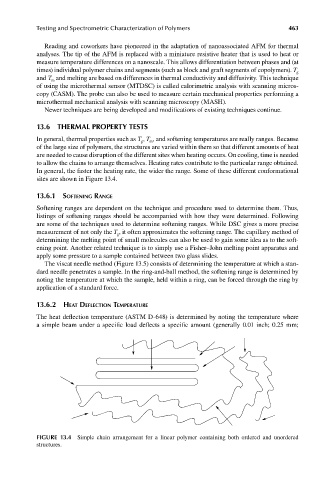Page 500 - Carrahers_Polymer_Chemistry,_Eighth_Edition
P. 500
Testing and Spectrometric Characterization of Polymers 463
Reading and coworkers have pioneered in the adaptation of nanoassociated AFM for thermal
analyses. The tip of the AFM is replaced with a miniature resistive heater that is used to heat or
measure temperature differences on a nanoscale. This allows differentiation between phases and (at
times) individual polymer chains and segments (such as block and graft segments of copolymers). T
g
and T and melting are based on differences in thermal conductivity and diffusivity. This technique
m
of using the microthermal sensor (MTDSC) is called calorimetric analysis with scanning micros-
copy (CASM). The probe can also be used to measure certain mechanical properties performing a
microthermal mechanical analysis with scanning microscopy (MASH).
Newer techniques are being developed and modifications of existing techniques continue.
13.6 THERMAL PROPERTY TESTS
In general, thermal properties such as T , T , and softening temperatures are really ranges. Because
g m
of the large size of polymers, the structures are varied within them so that different amounts of heat
are needed to cause disruption of the different sites when heating occurs. On cooling, time is needed
to allow the chains to arrange themselves. Heating rates contribute to the particular range obtained.
In general, the faster the heating rate, the wider the range. Some of these different conformational
sites are shown in Figure 13.4.
13.6.1 SOFTENING RANGE
Softening ranges are dependent on the technique and procedure used to determine them. Thus,
listings of softening ranges should be accompanied with how they were determined. Following
are some of the techniques used to determine softening ranges. While DSC gives a more precise
measurement of not only the T , it often approximates the softening range. The capillary method of
g
determining the melting point of small molecules can also be used to gain some idea as to the soft-
ening point. Another related technique is to simply use a Fisher–John melting point apparatus and
apply some pressure to a sample contained between two glass slides.
The viscat needle method (Figure 13.5) consists of determining the temperature at which a stan-
dard needle penetrates a sample. In the ring-and-ball method, the softening range is determined by
noting the temperature at which the sample, held within a ring, can be forced through the ring by
application of a standard force.
13.6.2 HEAT DEFLECTION TEMPERATURE
The heat deflection temperature (ASTM D-648) is determined by noting the temperature where
a simple beam under a specific load deflects a specific amount (generally 0.01 inch; 0.25 mm;
FIGURE 13.4 Simple chain arrangement for a linear polymer containing both ordered and unordered
structures.
K10478.indb 463 9/14/2010 3:42:15 PM
9/14/2010 3:42:15 PM
K10478.indb 463

